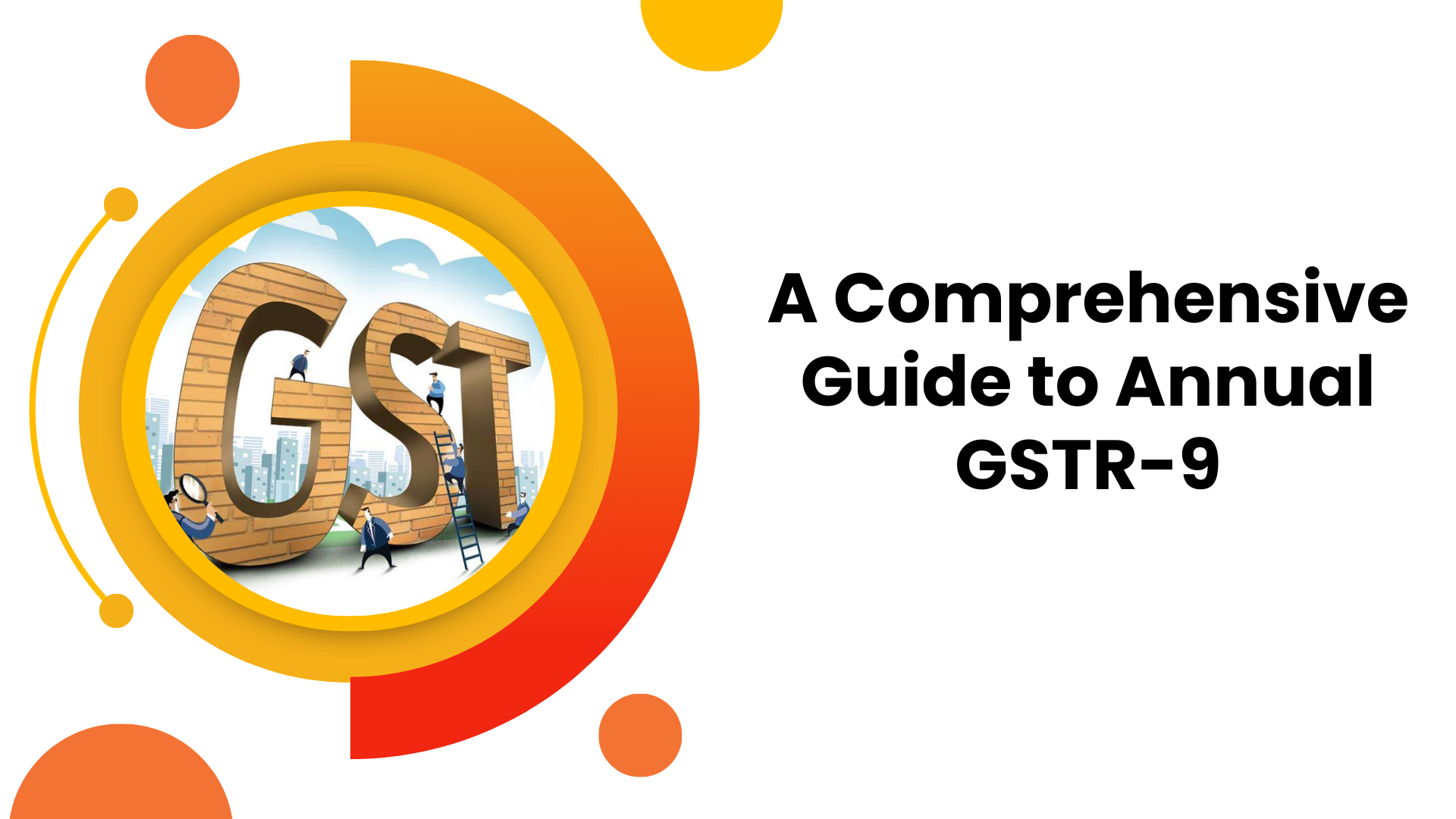Introduction:
Goods and Services Tax (GST) has revolutionized the Indian
indirect tax system, bringing transparency and simplification. To ensure
compliance and track the financial transactions of businesses, the government
introduced the Goods and Services Tax Return-9 (GSTR-9). GSTR-9 is an annual
return that businesses registered under GST must file, providing a
comprehensive overview of their financial activities for the fiscal year.
What is GSTR-9?
GSTR-9 is a detailed annual return that consolidates the
information furnished in monthly or quarterly GST returns during the financial
year. It is a summary of all the transactions, including sales, purchases,
input tax credit (ITC), and tax liabilities for a particular financial year.
This return is required to be filed by every registered taxpayer under GST,
except for certain categories such as casual taxable persons, non-resident
taxable persons, and input service distributors.
Components of GSTR-9:
- Part I: Basic Details - This section requires the
taxpayer to provide basic information such as the financial year for which the
return is being filed, GSTIN (Goods and Services Tax Identification Number),
legal name, trade name, and the period for which the audit is conducted.
- Part II: Outward and Inward Supplies - This part of the
return includes details about the outward and inward supplies made during the
financial year. It encompasses taxable supplies, exempt supplies, zero-rated
supplies, and non-GST supplies. It also requires information on advances
received and adjustments made during the year.
- Part III: ITC Reconciliation - In this section, taxpayers
need to reconcile the ITC claimed in their returns with the actual ITC
available as per the books of accounts. Any differences should be accounted for
and explained.
- Part IV: Tax Paid Reconciliation - This part involves the
reconciliation of the taxes paid as per the returns filed and the actual taxes
paid as per the books of accounts. Any discrepancies need to be addressed and
explained.
- Part V: Particulars of Demands and Refunds - Here,
taxpayers provide details of demands raised or refunds claimed during the
financial year, along with the action taken on them.
- Part VI: Other Information - This section covers various
aspects such as the HSN summary of outward and inward supplies, late fees, and
any additional liability arising out of the reconciliation.
Due Date and Penalties:
The due date for filing GSTR-9 is generally December 31st of
the subsequent financial year. However, this date may be subject to change, and
taxpayers are advised to check the latest notifications from the GST
authorities. Late filing of GSTR-9 may attract penalties, making it crucial for
businesses to adhere to the deadlines.
Benefits of GSTR-9
The filing of GSTR-9, the annual return under the Goods and
Services Tax (GST) system, provides several benefits for businesses and the
government. Here are some of the key advantages:
1. Comprehensive Overview:
GSTR-9 offers
businesses a comprehensive overview of their financial transactions throughout
the fiscal year. It consolidates the information from monthly or quarterly
returns, providing a holistic view of sales, purchases, input tax credit (ITC),
and tax liabilities.
2. Ensures Accuracy and Compliance:
By requiring
businesses to reconcile their data, GSTR-9 helps ensure the accuracy of the
information submitted to the GST authorities. This reconciliation process
encourages businesses to identify and rectify any discrepancies, promoting
compliance with GST regulations.
3. Facilitates ITC Reconciliation:
Part III of
GSTR-9 focuses on the reconciliation of Input Tax Credit (ITC). This section
encourages businesses to match the ITC claimed in their returns with the actual
ITC available as per their books of accounts. This process helps in identifying
and addressing any mismatches or errors.
4. Reduces Scope for Tax Evasion:
The detailed
nature of GSTR-9, along with the reconciliation requirements, makes it more
challenging for businesses to engage in tax evasion or fraudulent activities.
This contributes to a more transparent and accountable business environment.
5. Data Consistency and Accuracy:
GSTR-9 aids in
maintaining consistency and accuracy in the reporting of financial data. Businesses
are required to ensure that the data in their annual return aligns with the
information provided in their regular GST returns and financial records,
reducing the likelihood of errors.
6. Government Oversight:
For the
government, GSTR-9 serves as a valuable tool for overseeing and analyzing the
tax compliance of businesses. It provides insights into the financial health of
the business community and helps the government in identifying areas that may
require closer scrutiny or policy adjustments.
7. Improves Transparency:
By mandating a
detailed disclosure of various aspects of business transactions, GSTR-9
promotes transparency. This transparency is crucial for building trust between
businesses, government authorities, and other stakeholders in the ecosystem.
8. Simplifies Audits:
GSTR-9 simplifies
the audit process for businesses. By consolidating all relevant information in
one document, it makes it easier for auditors to review and verify a business's
compliance with GST regulations.
9. Legal Compliance:
Filing GSTR-9 is
a legal requirement for businesses registered under GST. Complying with this
obligation helps businesses avoid penalties and legal repercussions, ensuring a
smooth relationship with tax authorities.
10. Enhances Business Planning:
The detailed
information provided in GSTR-9 can be valuable for businesses in their
strategic planning and decision-making processes. It offers insights into the
financial performance, tax liabilities, and compliance status, enabling
businesses to make informed decisions for the future.
In summary, GSTR-9 is not just a compliance requirement; it
serves as a tool that benefits both businesses and the government by promoting
transparency, accuracy, and accountability in the GST system.
Conclusion:
GSTR-9 plays a pivotal role in ensuring GST compliance and transparency in financial transactions. Businesses need to meticulously compile and review their financial data to file an accurate and error-free return. Understanding the components of GSTR-9 is essential for businesses to navigate the complexities of GST registration and fulfill their regulatory obligations. Regular updates from the GST authorities and professional guidance can help businesses stay informed and compliant in this ever-evolving tax landscape.

